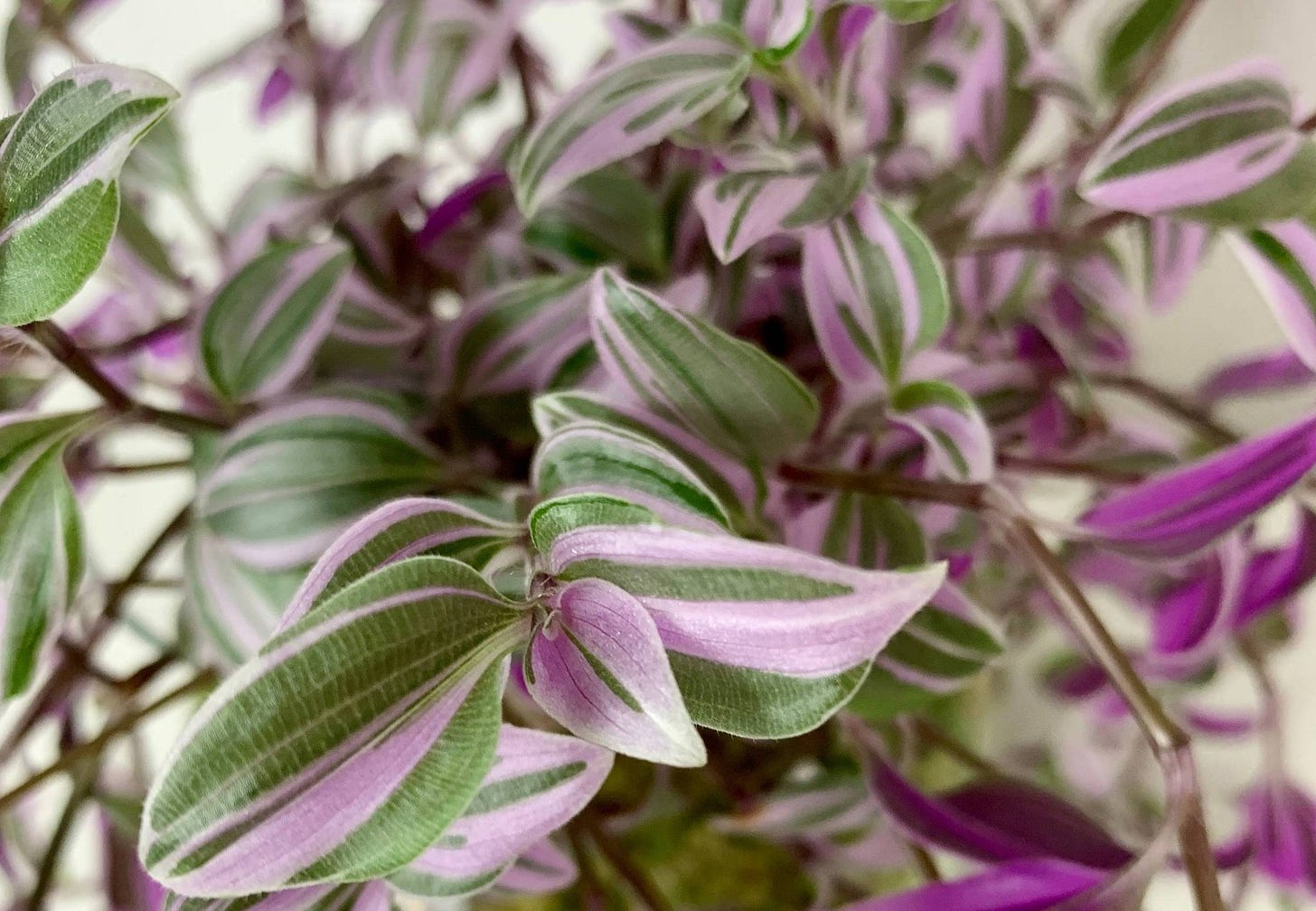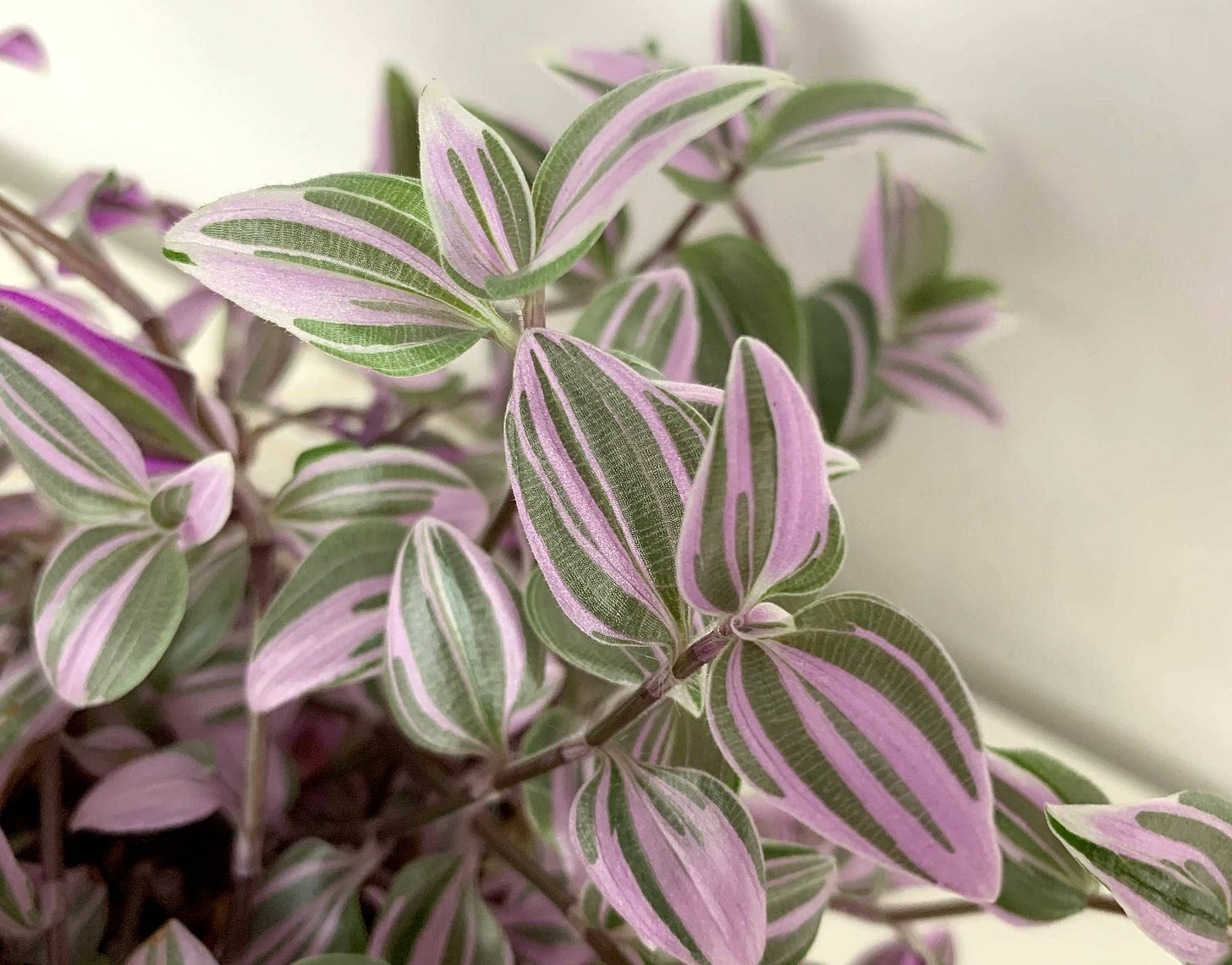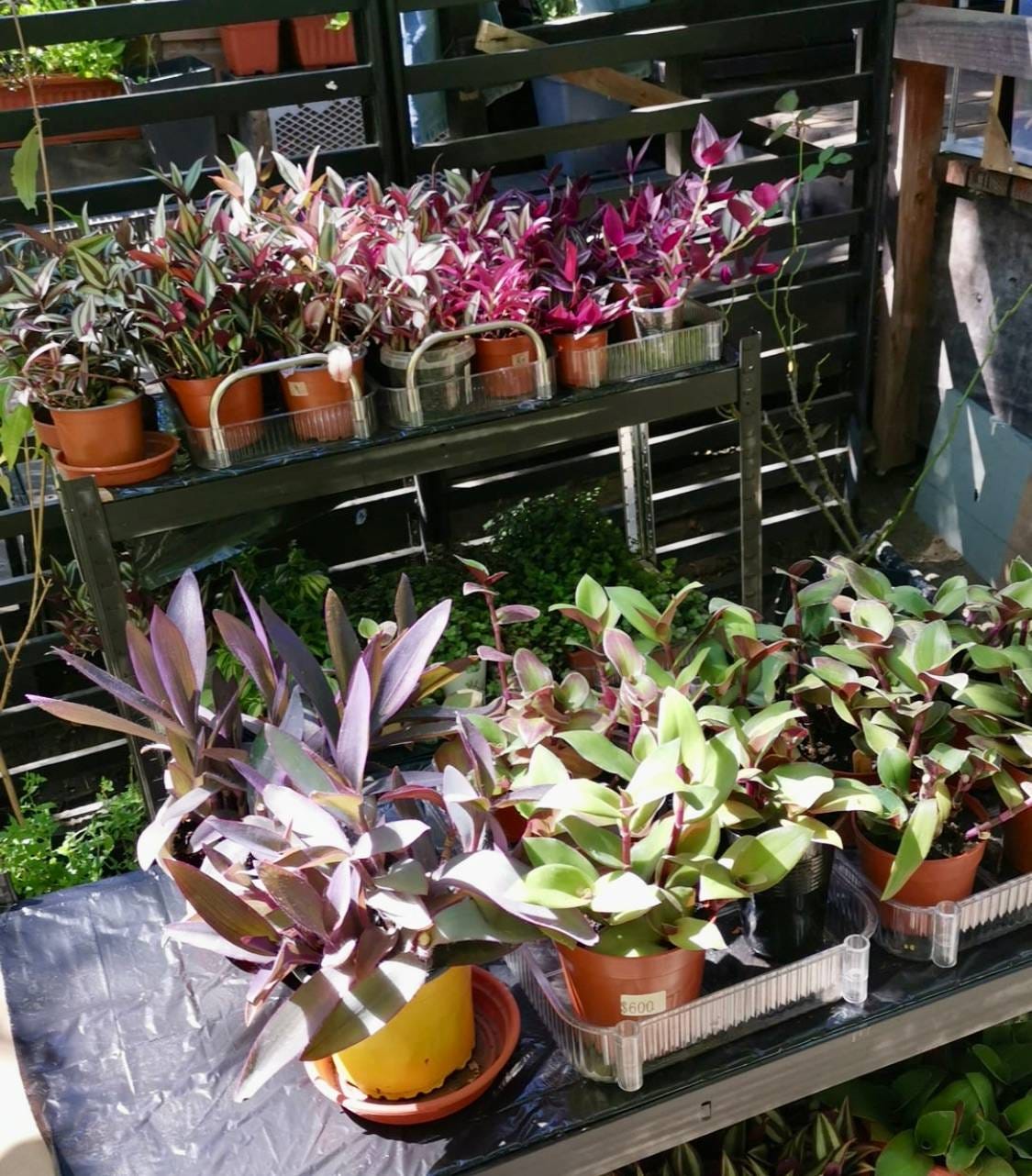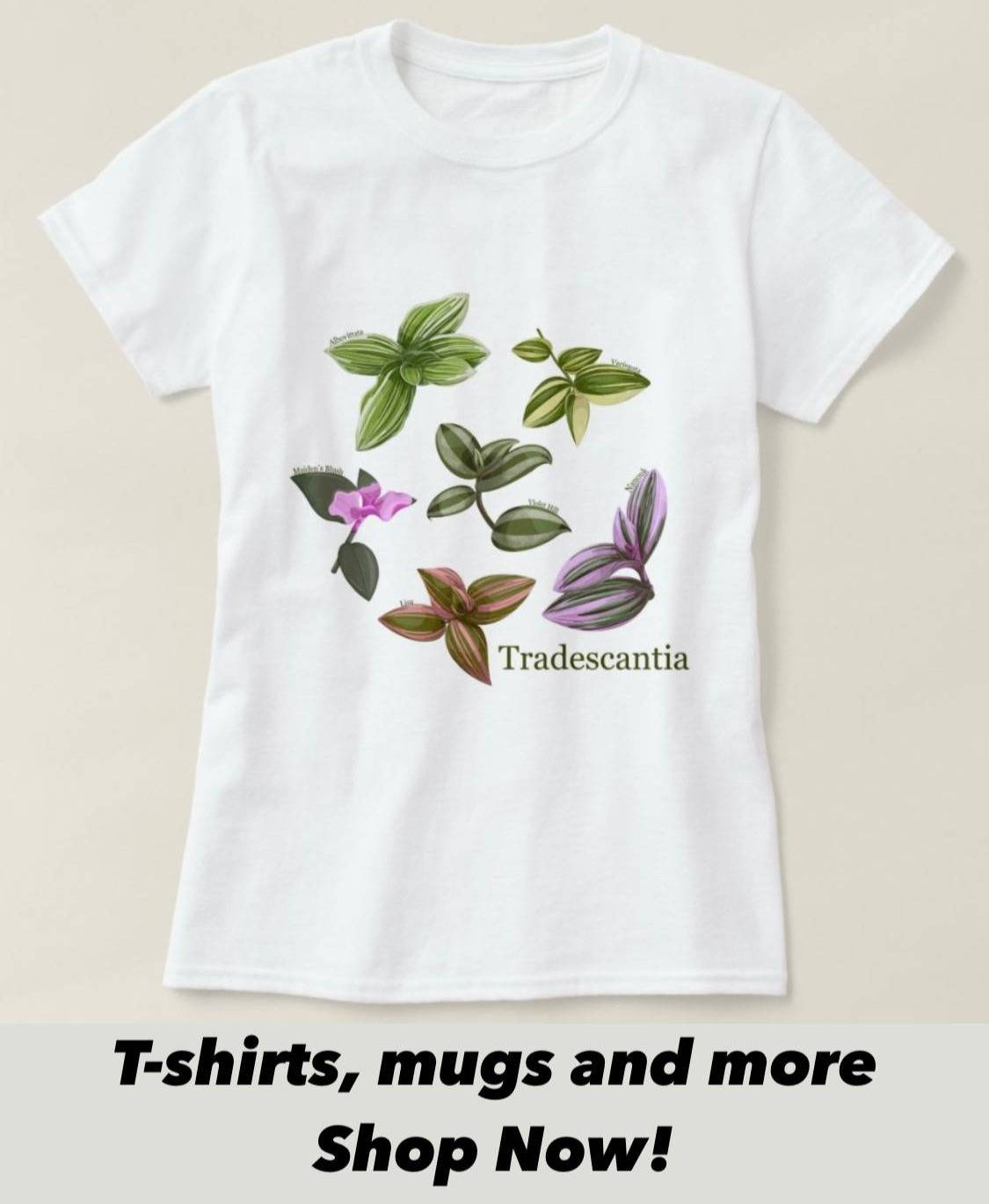Are You Watering Your Tradescantias the Right Way?
Many struggle with watering their Tradescantias, sometimes without even realizing it. Often, it’s hard to tell whether you’re giving too much or too little water. Common signs such as brown tips and soft, limp leaves are often misinterpreted as dehydration, leading many to overwater.
In reality, overwatering is a major reason why Tradescantias aren’t happy Without the right balance, your plants can suffer from root rot or may dry out too quickly, causing them to wilt and become stressed.
Don’t worry! In this edition, I’ll give you my best tips for watering your Tradescantias, to make sure they grow healthy and beautiful. You’ll discover how to spot the signs of water stress and learn the ideal watering techniques.
Plus, don’t miss out! In the Community Highlight, we meet Krystal from Chile, who shares her passion for Tradescantias. And in the ‘Tradescantia of the Week’ section, discover the charming ‘Fairy Wings!’
Tradescantia of the week: Mundula Fairy Wings
This week, let’s take a closer look at Fairy Wings, probably the smallest Tradescantia there is.
It belongs to the Mundula species, which is often mistaken for the Fluminensis species. But what sets Mundulas apart is the tiny, almost invisible hairs on their leaves.
Fairy Wings can at first be confused with Mundula Lisa (often incorrectly called Tricolor), but you can tell them apart by looking at the variegation.. Fairy Wings has Marginal Variegation, which means that each leaf has a pink border. The amount of pink can vary from leaf to leaf, but each one has green at the base with a pink margin. This type of variegation is quite stable and rarely reverts, unlike Sectoral variegation, which is what Lisa has. Sectoral variegation means that the pink and green show up in random stripes on every leaf. Both varieties, however, can revert to Green Hill.
I absolutely love its light purple colour. I got mine about a year ago, and while it took some time to take off, it has now grown into the cutest little plant. It fits perfectly in my hanging glass pot. I’m hoping I will get to see it bloom this spring, with its small white flowers.
Are You Watering Your Tradescantias the Right Way?
Today, I thought it was time to talk about one of the most important aspects of plant care, watering.
It might seem simple, but watering your Tradescantias correctly is key to keeping them happy and healthy.
Are you wondering if you’re giving your Tradescantias too much, too little, or just the right amount of water? You’re not alone. Many plant parents struggle to find the perfect balance.
That’s why I want to help you better understand your plants and their watering needs. From choosing the right pot to understanding the best times and methods for watering
Watering Basics for Your Tradescantias
Watering Frequency: There’s no one-size-fits-all rule for watering Tradescantias. Their needs depend on several factors like light exposure, pot size, soil type, room temperature, humidity, and the season. There isn’t a fixed schedule you can follow or a specific amount of water that is always correct. It’s time to water when the soil has completely dried out.
How Much Water to Use: When you water, be thorough. Water should flow out of the drainage holes at the bottom of the pot, making sure that the soil is completely saturated. This way, all the roots get the moisture they need. If you choose to bottom water, make sure the soil is fully saturated before removing the plant from the water.
Seasonal Adjustments: Keep in mind that your plant’s water needs will change with the seasons. Tradescantias generally need more water during the growing months of spring and summer and less during the darker months of fall and winter. Their watering needs are also affected by light levels, so if you are using grow lights during winter, their water needs might not change much.
Choosing the Right Pot for Your Tradescantias
The type of pot you choose for your Tradescantias can make a big difference in how well they grow and how you water them.
Material: Pots come in various materials such as plastic, ceramic, and terracotta, each with its own advantages and drawbacks. Plastic pots are lightweight and retain moisture well, making them probably the easiest option if you’re unsure about watering your plants. Ceramic pots, while heavier and often more decorative, can help regulate soil moisture by absorbing excess water. Terracotta pots are porous, which allows air and water to move through the walls, helping the soil dry out faster, a great option for those who tend to overwater.
Drainage: This is crucial. Always choose pots with good drainage holes to help excess water drain away, which is vital for preventing soil from becoming waterlogged and damaging the roots. If you fall in love with a pot that lacks drainage, consider drilling a hole or using it as a decorative cache pot, placing the actual plant in a smaller container inside that has proper drainage.
Size: The size of the pot should be proportional to your plant. A pot that’s too large can hold too much water, leading to soggy soil and potentially root rot, while a pot that’s too small might dry out too quickly before your plant has a chance to hydrate properly. It’s generally best to choose a pot that allows the plant’s root system to grow comfortably without being cramped.
Choosing the right pot will affect your watering routine. Making smart choices here can save you a lot of trouble down the road.
Understanding Soil Types for Your Tradescantias
The type of soil you use for your Tradescantias can greatly affect how often you need to water. Here’s what you need to know about soil:
General Soil Needs: Tradescantias do well in well-draining soil because it prevents water from sitting too long around the roots, which can cause rot. A good potting mix for these plants typically includes components like perlite or pumice, which aid in drainage and air flow. If you find that your soil isn’t draining as well as you’d like, consider mixing in more perlite, pumice, or coarse sand to increase its porosity and improve drainage.
Alternatively, adjusting your watering routine can also be effective, just make sure you allow the soil to dry out between waterings to keep your plants healthy.
Choosing the Right Mix: While general potting soil can be a good start, consider mixing your own or buying a pre-made mix better suited for Tradescantias. If you want to know more about what soil to use, you can read about it here.
Checking Soil Moisture Before Watering
This is probably the most important point when it comes to watering. Knowing when to water your Tradescantias isn’t just about sticking to a schedule; it’s about understanding the needs of your plant based on the moisture level of the soil. Personally, I never water my plants without checking the soil first. Here’s how you can do the same:
Use a Stick or Your Finger: The simplest way to check soil moisture is by using a stick or your finger. However, this method can be challenging for larger pots, as it might be difficult to reach deep enough to check the bottom of the pot.
Use a Moisture Meter: If you’re new to plants, I would recommend investing in a moisture meter. It can give you a better indication of how moist the soil is, which is especially helpful if you’re unsure about what the soil should feel like.
Weigh the Pot: Another method is to lift the pot. A lighter pot usually indicates that the soil has dried out, whereas a heavier one suggests that there’s still plenty of moisture. This method can take a bit of experience to get right, as you’ll need to know how the pot feels when the soil is wet versus dry.
Know What a Dehydrated Tradescantia Looks Like: While it’s not a method I recommend using, it can be helpful to know what your plants look like when they’re dehydrated. I can spot a dehydrated Tradescantia from across the room, and it has saved me many times from forgetting to water. A dehydrated plant has weak, shiny leaves, and get a dull, faded colour. It won’t hurt your plant to get dehydrated like this every now and then, but it’s better to water before this happens.
Regularly checking the soil moisture can prevent overwatering and underwatering, both of which can lead to health problems for your Tradescantias.
Top Watering vs. Bottom Watering
When it comes to watering your Tradescantias, you have two main methods to consider: top watering and bottom watering. Each method has its own set of advantages and is suited to different care routines and plant needs.
Top Watering: This is the traditional method where water is poured directly over the top of the soil until it comes out of the drainage holes at the bottom of the pot.
Pros:
Helps wash out salts and minerals from fertilizers that can build up in the pot, which could potentially harm the plant over time.
It’s faster and easier.
Cons:
If not done carefully, it can lead to uneven watering, with some roots getting more water than others. Especially if the soil has become hydrophobic, water can come out the bottom before it has reached all the soil, leaving some parts of the pot dry and roots without water.
Top watering can also create moist conditions on the soil surface, ideal for fungus gnats.
Bottom Watering: For this method, you place the plant in a container of water, allowing the water to absorb upwards through the drainage holes into the soil.
Pros:
Promotes even distribution of water throughout the pot, letting it reach all the roots.
Helps keep the soil surface drier, which can reduce fungus gnats, as they like moist soil conditions.
Cons:
It’s difficult to tell when the soil has been saturated fully, which might lead to insufficient watering. If the soil has become hydrophobic, it might have trouble soaking up enough water.
Does not flush out excess salts and mineral buildups as effectively as top watering.
Takes longer and requires more effort since the pot needs to be moved into a container filled with water.
Choosing between top and bottom watering will depend on your plants and your routine. Both methods work well, and you can even combine the two. Just make sure you saturate the soil fully every time.
How I Water My Tradescantias
With around 100 plants to care for at home, I don’t have time for complicated watering routines. To make things easier, most of my plants are in plastic pots set in trays. This setup simplifies the watering process, and lets me use a combination of top and bottom watering.
Here’s what I do:
I start by watering from the top until water runs out the bottom of the pot.
Next, I fill up the tray with water and let the plants soak from the bottom.
If the water in the tray is absorbed quickly, I refill it. If there’s still water left after an hour, I empty it (though I usually forget). This makes sure the soil is fully saturated.
By letting the soil dry completely before watering again, I effectively prevent overwatering.
FAQs or Troubleshooting Common Issues
Q: What should I do if I overwatered my Tradescantia?
A: Overwatering is often misunderstood. It doesn’t happen from watering too much at one time, as excess water should drain out the bottom if you have proper drainage holes. Instead, overwatering happens by watering too often, not allowing the soil to dry out enough between waterings. This is why it’s important to always check the soil before watering.
If you suspect overwatering, common signs are yellowing leaves, soft mushy stems, and rotting leaves and stems. Here’s what you can do:
If the soil is very wet, the best course of action is to trim off all healthy parts of the plant and repot them in fresh, lightly damp soil.
If the plant is in very bad shape, consider propagating healthy parts in sphagnum moss as this can be more forgiving and promote recovery.
Q: How do I know if I’m watering my Tradescantias enough?
A: The best way to know if you’re watering enough is to check the soil moisture regularly. Saturate the soil completely every time, then allow it to dry out completely before watering again. Tradescantias are quite resilient thanks to their ability to store water in their leaves and stems, so letting the soil dry out will not harm your plant.
Q: Won’t letting my Tradescantia dry out cause the leaf tips to turn brown?
A: No, allowing the soil to dry out is not typically what causes leaf tips to turn brown. Brown tips on Tradescantia leaves are more often due to other factors, such as overwatering, over-fertilizing, or environmental stresses like temperature changes. If you suspect that over-fertilization is the issue, you can flush the soil with water to help remove accumulated salt buildups.
Community Highlight
Today, I want to introduce you to Krystal, from the south of Chile, or as she describes it, the land of volcanoes and earthquakes. She shares her plants and her Tradescantia journey on Instagram at @tradeskrys and @_kryzis_.
What’s your favorite Tradescantia and why? “It’s hard to choose one, but I think I would go with Zebrina and all its varieties. I especially love Zebrina Burgundy.”
Which was your first Tradescantia, and where did you get it? “I got my first Tradescantia, a Zebrina, in 2023 at a place that sells fruits and vegetables. It was indeed love at first sight.”
What’s the #1 Tradescantia on your wishlist? “I wish I had a Zebrina Quadricolor.”
What’s one care tip or trick you swear by for your Tradescantias? “One tip that I truly go by is chopping off stems of Tradescantias to make them grow bushier and to create new plants!”
Any fun or unexpected stories about your Tradescantias you’d like to share? “I first saw a Tradescantia in 2023, and I immediately fell in love with its beauty. I started reading about them and the next day I recognized a Cerinthoides that was dying outside in the wild. Since then, I have been propagating non-stop and also buying more plants. I now have 132 small and big Tradescantias. I intend on selling Tradescantias in the near future!
Do you have a Tradescantia collection? Or maybe one or two you’re especially proud of? Why not show it off in the next newsletter’s Community Highlight?
Reply to this email, email me at katja@exploringtradescantias.com, or send me a DM on Instagram, I’d love to feature your favorite plants!
Until next time, happy planting! 🌿
Katja
Disclaimer: This is an affiliate link, which means I earn a small commission if you make a purchase using my code, at no extra cost to you. Your support helps me keep sharing Tradescantia tips and content—thank you!








